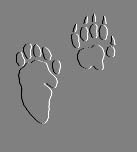STRIPED SKUNK
(Mephitis mephitis)
|

Enlarge Photo

Tracks
|
Mass: 700 to 2500 g
Length: to 32 in. (81 cm)
Biomes: temperate forest & rainforest, temperate grassland
Status: no special status.
Range: The striped skunk can be found from central Canada south to northern Mexico. It is only found in North America.
Hiker's Note:
The striped skunk is easily recognized by its characteristic colors and pattern. Its fur is black with a white stripe that begins as a triangular shape on the
top of the head, forks into two stripes that travel down the sides of the back, and usually merges again near the base of the tail. It also has a separate white stripe running from the base of the snout up between the eyes and ending on the forehead. Stripe width and length vary with each individual. Stripes sometimes occur on the tail, but more often the tail is composed of both black and white hairs intermixed. Mephitis mephitis is about the size of a domestic cat, with a small head, small ears, short legs, and a long, fluffy tail. Feet are plantigrade with five partially webbed toes. Claws are longer on the front feet to aid in digging.
Mephitis mephitis has perhaps the most widely known defense system of any mammal, the scent-spraying mechanism. A striped skunk usually does not dispatch its spray unless its life is in danger. When faced with danger, it arches its back and erects its tail and hair. When it feels mortally threatened, it bends into a U-shape with both head and rump facing the enemy. It then squirts out two streams of fluid from scent glands located just inside the anus, which meet after travelling about a foot, finally spreading into a fine spray that can travel up to 2 or 3 meters. The spray often causes nausea and burns the eyes and nasal cavities of the unfortunate target. The spray is also used by males to communicate with the opposite sex during mating season and to mark their territories.
They are one of the primary reservoirs of sylvatic rabies and thus can be very dangerous to pets and humans.
Hind print is 2 - 3 in. (5 - 8 cm.) long; Fore print is 1 - 2 in. (3 - 5 cm.) long. While all paws are clawed, only the fore prints typically only show them.
References
|


